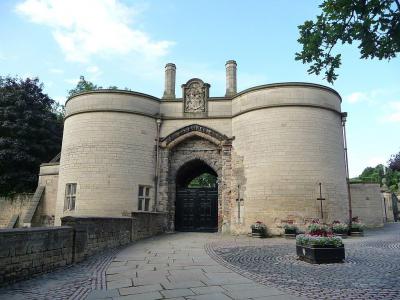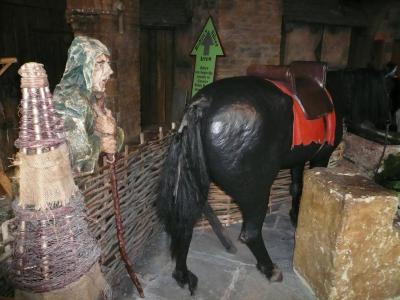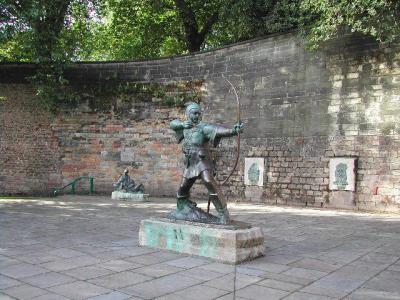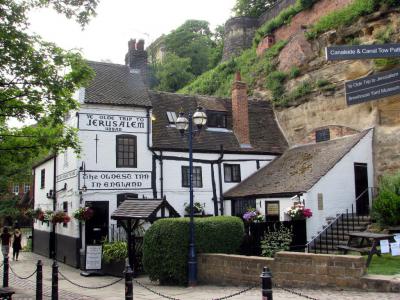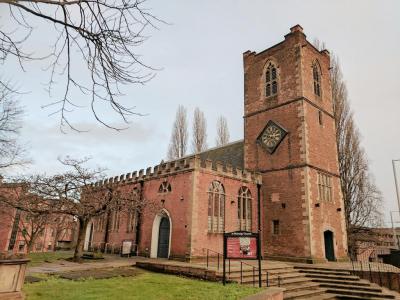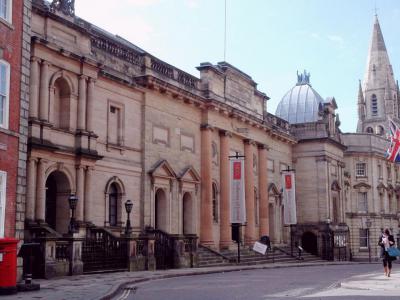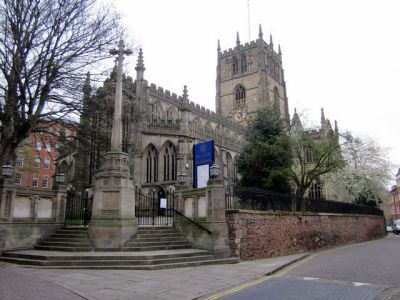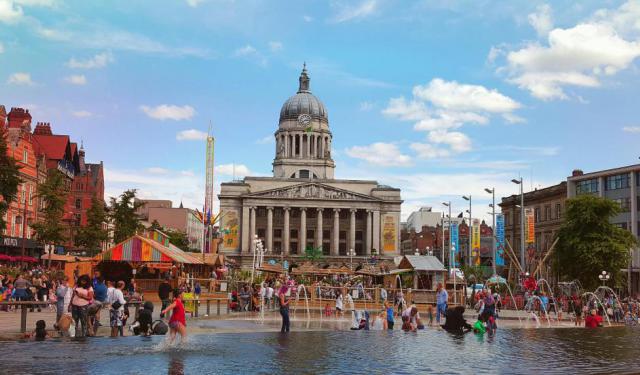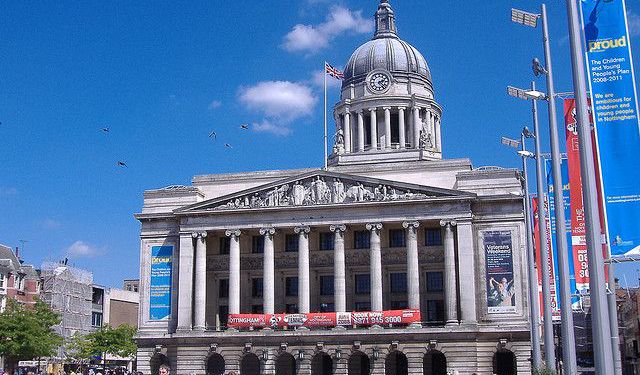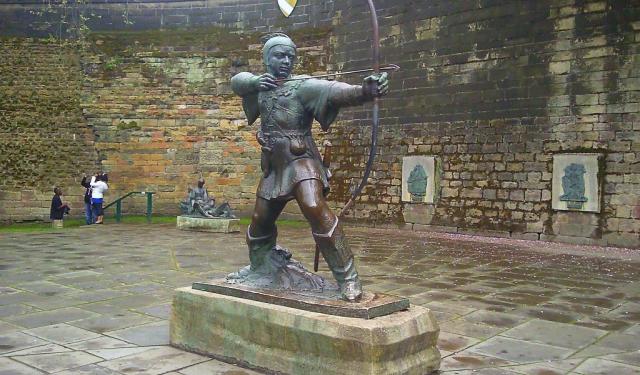
Robin Hood Trail (Self Guided), Nottingham
There's hardly anyone on this planet who hasn't heard of Robin Hood. Apparently, a Saxon nobleman born in 1160 in Loxley, this hero of numerous ballads, some dating back as far as the 14th century, earned fame by robbing from the rich and giving it back to the poor. A skilled archer and sword fighter as he was, Robin Hood famously defended villagers from attacks by corrupt noblemen, prime amongst whom was his arch-nemesis, the evil Sheriff of Nottingham.
According to legend, the key events of Robin Hood's life took place in and around Nottingham. It is therefore not surprising that the city is littered with landmarks associated with the adventures of Robin Hood and his Merry Men, much as his beloved Maid Marian. Some of these places are found in downtown Nottingham, within a walking distance of each other, each with its own story of Robin Hood, and as such offer the most reward for your time.
Nottingham Castle – Prince John, the usurper king in the Robin Hood tales, occupied this strategic fortress when he rebelled against his brother, King Richard I (Lionheart).
Robin Hood Statue – a popular photo spot outside of the castle, depicts Robin Hood with his bow and arrow, poised to defend the city.
Ye Olde Trip to Jerusalem – attached to Nottingham Castle’s foundation, it is said to be the ‘oldest inn in England’ (est. 1189); formerly a meeting point for Crusaders, among whom was Robin Hood.
National Justice Museum – housed in the medieval Shire Hall, the seat of power of the Sheriff of Nottingham; underneath the building is a dungeon where Robin Hood was reportedly imprisoned.
St. Mary's Church – right across from the Museum; here Robin Hood was betrayed by a dishonest monk and attacked by the Sheriff, whilst praying, prior to being captured.
To learn more about the legendary outlaw and to find out what made him such a beloved and enigmatic figure throughout the centuries, take this self-guided Robin Hood tour of Nottingham.
According to legend, the key events of Robin Hood's life took place in and around Nottingham. It is therefore not surprising that the city is littered with landmarks associated with the adventures of Robin Hood and his Merry Men, much as his beloved Maid Marian. Some of these places are found in downtown Nottingham, within a walking distance of each other, each with its own story of Robin Hood, and as such offer the most reward for your time.
Nottingham Castle – Prince John, the usurper king in the Robin Hood tales, occupied this strategic fortress when he rebelled against his brother, King Richard I (Lionheart).
Robin Hood Statue – a popular photo spot outside of the castle, depicts Robin Hood with his bow and arrow, poised to defend the city.
Ye Olde Trip to Jerusalem – attached to Nottingham Castle’s foundation, it is said to be the ‘oldest inn in England’ (est. 1189); formerly a meeting point for Crusaders, among whom was Robin Hood.
National Justice Museum – housed in the medieval Shire Hall, the seat of power of the Sheriff of Nottingham; underneath the building is a dungeon where Robin Hood was reportedly imprisoned.
St. Mary's Church – right across from the Museum; here Robin Hood was betrayed by a dishonest monk and attacked by the Sheriff, whilst praying, prior to being captured.
To learn more about the legendary outlaw and to find out what made him such a beloved and enigmatic figure throughout the centuries, take this self-guided Robin Hood tour of Nottingham.
How it works: Download the app "GPSmyCity: Walks in 1K+ Cities" from Apple App Store or Google Play Store to your mobile phone or tablet. The app turns your mobile device into a personal tour guide and its built-in GPS navigation functions guide you from one tour stop to next. The app works offline, so no data plan is needed when traveling abroad.
Robin Hood Trail Map
Guide Name: Robin Hood Trail
Guide Location: England » Nottingham (See other walking tours in Nottingham)
Guide Type: Self-guided Walking Tour (Sightseeing)
# of Attractions: 7
Tour Duration: 1 Hour(s)
Travel Distance: 1.5 Km or 0.9 Miles
Author: StaceyP
Sight(s) Featured in This Guide:
Guide Location: England » Nottingham (See other walking tours in Nottingham)
Guide Type: Self-guided Walking Tour (Sightseeing)
# of Attractions: 7
Tour Duration: 1 Hour(s)
Travel Distance: 1.5 Km or 0.9 Miles
Author: StaceyP
Sight(s) Featured in This Guide:
- Nottingham Castle
- The Robin Hood Experience
- Robin Hood Statue
- Ye Olde Trip to Jerusalem
- St. Nicholas Church
- National Justice Museum
- St. Mary's Church
1) Nottingham Castle (must see)
Sat atop a natural rocky promontory known as "Castle Rock", 130 feet (40 m) above the city, the Nottingham Castle is a strategic fortress that once occupied a commanding position on a major road leading to the north of England.
The first wooden, motte-and-bailey fort on this site was built in 1068 by the invading Normans on the orders of William the Conqueror. During the reign of King Henry II, the wooden structure was replaced by a far more defensible stone castle. The construction was further added to throughout the Middle Ages, and emerged as an important royal stronghold and occasional residence used by Medieval kings as a stopping point on their journeys. The elaborate cave system underneath the citadel stood witness to a number of accounts of royal and political intrigue.
In the absence of King Richard I ("the Lionheart"), who was away on the Third Crusade to the Holy Land, the Castle was taken over by his treacherous brother, Prince John, portrayed in the Robin Hood story as the usurper king; among his supporters was the Sheriff of Nottingham. The legend has the Castle as the scene of a final showdown between the heroic outlaw and the evil Sheriff.
By 1600, the Castle had fallen into decline, rendered militarily obsolete by the arrival of artillery. It was already in a semi-ruined state, following a number of skirmishes on the site, when the English Civil War broke out. All except for its medieval foundations was practically razed in 1651, at the end of the War.
In the 1670s William Cavendish, Duke of Newcastle, built on Castle Rock a Stuart Restoration-era "Ducal Mansion". This ducal palace was torched during the Reform Act riots of 1831 and left as a ruin for another 40 years. It was renovated in the 1870s to house an art gallery and Nottingham Castle Museum, still in use. Of the original castle have survived only the gatehouse and parts of the ramparts, pointed arches and a subterranean tunnel, called "Mortimer's Hole", associated with Robin Hood.
The Castle underwent extensive renovation from 2018 to 2021 with a new visitor center installed, new exhibitions and galleries added, complete with interactive displays, a children's adventure section based on Robin Hood, and a Nottingham Lace exhibit. The Castle also holds the regimental museum of the Sherwood Foresters and has Robin Hood iconography throughout its gardens.
The first wooden, motte-and-bailey fort on this site was built in 1068 by the invading Normans on the orders of William the Conqueror. During the reign of King Henry II, the wooden structure was replaced by a far more defensible stone castle. The construction was further added to throughout the Middle Ages, and emerged as an important royal stronghold and occasional residence used by Medieval kings as a stopping point on their journeys. The elaborate cave system underneath the citadel stood witness to a number of accounts of royal and political intrigue.
In the absence of King Richard I ("the Lionheart"), who was away on the Third Crusade to the Holy Land, the Castle was taken over by his treacherous brother, Prince John, portrayed in the Robin Hood story as the usurper king; among his supporters was the Sheriff of Nottingham. The legend has the Castle as the scene of a final showdown between the heroic outlaw and the evil Sheriff.
By 1600, the Castle had fallen into decline, rendered militarily obsolete by the arrival of artillery. It was already in a semi-ruined state, following a number of skirmishes on the site, when the English Civil War broke out. All except for its medieval foundations was practically razed in 1651, at the end of the War.
In the 1670s William Cavendish, Duke of Newcastle, built on Castle Rock a Stuart Restoration-era "Ducal Mansion". This ducal palace was torched during the Reform Act riots of 1831 and left as a ruin for another 40 years. It was renovated in the 1870s to house an art gallery and Nottingham Castle Museum, still in use. Of the original castle have survived only the gatehouse and parts of the ramparts, pointed arches and a subterranean tunnel, called "Mortimer's Hole", associated with Robin Hood.
The Castle underwent extensive renovation from 2018 to 2021 with a new visitor center installed, new exhibitions and galleries added, complete with interactive displays, a children's adventure section based on Robin Hood, and a Nottingham Lace exhibit. The Castle also holds the regimental museum of the Sherwood Foresters and has Robin Hood iconography throughout its gardens.
2) The Robin Hood Experience
At number 94 Friar Lane in Nottingham, not far from Nottingham Castle, is a storefront shop where they sell experience. Enter the shop and step back in time to the medieval era of Richard the Lionheart and Robin Hood, but mostly, Robin Hood. Peasants will explain how much they owe to Master Robin and what a nasty fellow the Sheriff of Nottingham is.
The experience is assisted mightily thorough life-like cinematic holograms. Here are the sights and sounds of the middle ages, and even the smells(!). It's all very credible. The middle ages without the Plague. When the tour through time ends, one has a meeting with a Master Bowman (live). He tells the history and uses of the classic longbow of England.
The Experience is a family-oriented, interactive story tour through three floors and a gift shop. There is a wealth of souvenirs and books based on the amazing story of the peasant warrior who stole from the rich and gave to the poor. The Experience is open from 10 am to 6 pm Thursday through Monday.
The experience is assisted mightily thorough life-like cinematic holograms. Here are the sights and sounds of the middle ages, and even the smells(!). It's all very credible. The middle ages without the Plague. When the tour through time ends, one has a meeting with a Master Bowman (live). He tells the history and uses of the classic longbow of England.
The Experience is a family-oriented, interactive story tour through three floors and a gift shop. There is a wealth of souvenirs and books based on the amazing story of the peasant warrior who stole from the rich and gave to the poor. The Experience is open from 10 am to 6 pm Thursday through Monday.
3) Robin Hood Statue
Robin Hood stands before Nottingham Castle like John Wayne before the Alamo. He is a stocky medieval woodsman with a drawn longbow. His arrow, made of hardened cannon metal, is aimed at Nottingham Castle. Down with the Establishment! The statue was commissioned in 1949 by businessman Philip Clay and created by Royal Academy sculptor, James Woodford.
It seems that everyone, including celebrities that come to Nottingham, just has to have a picture taken with Master Robin. Brian Clough, Cilla Black, Pudsy Bear, Brian Blessed, The Killers, Wallace and Gromit, dancers from Cirque du Soleil and a slew of topless models have all made the scene.
The statue is bigger than life. It is seven feet tall, standing on a rough stone plinth. It was unveiled in 1952. It is composed of eight pieces of bronze weighing more than half a ton. On the bank behind Robin are plaques telling the tale of Robin Hood. Plus, there are sculptures of the Merry Men of Sherwood Forest.
The statue has become a trademark of Nottingham around the world. Robin takes aim at the castle remains of William the Conqueror, "Here Billy, conquer this!"
It seems that everyone, including celebrities that come to Nottingham, just has to have a picture taken with Master Robin. Brian Clough, Cilla Black, Pudsy Bear, Brian Blessed, The Killers, Wallace and Gromit, dancers from Cirque du Soleil and a slew of topless models have all made the scene.
The statue is bigger than life. It is seven feet tall, standing on a rough stone plinth. It was unveiled in 1952. It is composed of eight pieces of bronze weighing more than half a ton. On the bank behind Robin are plaques telling the tale of Robin Hood. Plus, there are sculptures of the Merry Men of Sherwood Forest.
The statue has become a trademark of Nottingham around the world. Robin takes aim at the castle remains of William the Conqueror, "Here Billy, conquer this!"
4) Ye Olde Trip to Jerusalem
The name needs translating. "Ye" is pronounced "the." "Trip" meant a stop along the way, not the last stop. There were many more pubs along the way to Jerusalem. If the pilgrim hit every one, he might never get there. Imagine Crusader knights leaving the castle and riding to the pub to have "one for the road" before leaving for the Holy Land.
The pub is a three story whitewashed brick building. It is backed into the cliffs of Castle Rock. Above the entrance a painted sign proclaims the pub to be the "oldest inn in England." Perhaps. It is old enough to have served Richard the Lionheart and his jolly knights, and Robin Hood and his Merry Men.
Before 1799 the pub was known as "The Pilgrim." Locally, it is often referred to as "The Trip." Other pubs claim to be the oldest in England. In Nottingham alone, that claim is made by Ye Olde Salutation Inn and the Bell Inn.
The pub asserts it was operating as early as 1189 AD. The caves the pub is built against were certainly used as a brewhouse for Nottingham Castle in 1068. The oldest parts of the present building were most likely built around 1660. John Speed, a cartographer of the time, shows a building there in 1610.
The pub is like a cross between a pub and a museum. There are several bars and lounges holding artifacts of Nottingham's history. Favorite rooms are the Rock Bar or Yorkie's Lounge. There is also an extensive garden. Under the pub are some of the 800 caves carved into the sandstone cliffs of Nottingham.
The pub is a three story whitewashed brick building. It is backed into the cliffs of Castle Rock. Above the entrance a painted sign proclaims the pub to be the "oldest inn in England." Perhaps. It is old enough to have served Richard the Lionheart and his jolly knights, and Robin Hood and his Merry Men.
Before 1799 the pub was known as "The Pilgrim." Locally, it is often referred to as "The Trip." Other pubs claim to be the oldest in England. In Nottingham alone, that claim is made by Ye Olde Salutation Inn and the Bell Inn.
The pub asserts it was operating as early as 1189 AD. The caves the pub is built against were certainly used as a brewhouse for Nottingham Castle in 1068. The oldest parts of the present building were most likely built around 1660. John Speed, a cartographer of the time, shows a building there in 1610.
The pub is like a cross between a pub and a museum. There are several bars and lounges holding artifacts of Nottingham's history. Favorite rooms are the Rock Bar or Yorkie's Lounge. There is also an extensive garden. Under the pub are some of the 800 caves carved into the sandstone cliffs of Nottingham.
5) St. Nicholas Church
There are only three medieval churches left in Nottingham: St Peter's, St Mary's, and St Nicholas (known locally as St Nic's). In each case, while the foundation may be pre-Norman, the rest of the building is relatively recent, and still in use. The original church dedicated to St Nicholas, built on the site of the present temple in the 11th or 12th century, is said to be the place where Robin Hood would come to pray regularly as well as to hide.
From the very earliest ballads about Robin Hood we learn that he, although declared bishops and archbishops to be his main enemies, was a keen worshiper of Virgin Mary. St Nicholas Church stands in what was the predominantly Saxon part of Nottingham town after the uprisings that followed the Norman Conquest. If Robin Hood was indeed linked in some way to those who lost lands and property to the Norman lords, he could have well felt at home here amongst the congregation.
What time could not accomplish, war did in a flash in 1643. During the English Civil War, Royalist troops ensconced in the church tower directed a bombardment on units of the Parliament Army holding Nottingham Castle. After the engagement, Colonel John Hutchinson, who was in command of the Castle, ordered the church completely destroyed.
The current building dates from 1671-1678. The exterior of the replacement St Nicholas is plain and devoid of much ornament. The tower is square, in three stages. The middle stage has a clock on two sides, facing front and back. Above the clocks are tall arched widows. The edges of the tower roof are crenelated. There are two bells in the tower.
The church is cruciform; aisles and galleries were added in the 18th century. Parts of the galleries still remain after renovations in the 19th century. The four-centered chancel arch is complemented by the paneling of the ceiling. Over the two northern doors in the rood loft are blazons and escutcheons of the royal arms.
From the very earliest ballads about Robin Hood we learn that he, although declared bishops and archbishops to be his main enemies, was a keen worshiper of Virgin Mary. St Nicholas Church stands in what was the predominantly Saxon part of Nottingham town after the uprisings that followed the Norman Conquest. If Robin Hood was indeed linked in some way to those who lost lands and property to the Norman lords, he could have well felt at home here amongst the congregation.
What time could not accomplish, war did in a flash in 1643. During the English Civil War, Royalist troops ensconced in the church tower directed a bombardment on units of the Parliament Army holding Nottingham Castle. After the engagement, Colonel John Hutchinson, who was in command of the Castle, ordered the church completely destroyed.
The current building dates from 1671-1678. The exterior of the replacement St Nicholas is plain and devoid of much ornament. The tower is square, in three stages. The middle stage has a clock on two sides, facing front and back. Above the clocks are tall arched widows. The edges of the tower roof are crenelated. There are two bells in the tower.
The church is cruciform; aisles and galleries were added in the 18th century. Parts of the galleries still remain after renovations in the 19th century. The four-centered chancel arch is complemented by the paneling of the ceiling. Over the two northern doors in the rood loft are blazons and escutcheons of the royal arms.
6) National Justice Museum (must see)
On the street of High Pavement, occupying one side of the Lace Market, stands the Shire Hall and County Gaol (jail). Back in medieval times this was also known as the "Sheriff's Hall", the seat of power of the Sheriff of Nottingham from which he enforced law and order in Nottinghamshire.
The "justice" meted out here in those days rendered Shire Hall a somewhat spooky place, with ghosts and shadowy figures reported, especially in the chapel and the caves. Indeed, underneath the building is an oubliette (a dungeon; from French meaning ‘to forget’) where, back in the day, none other than Robin Hood himself was imprisoned.
As time went by, the medieval structure fell into disrepair. In 1724 the courtroom floor collapsed during a trial, seeing everyone and everything drop into the caves beneath. The presiding judge, however, calmly looking on, granted a continuance.
Presently, both Shire Hall and its Edwardian neighbour house the largest justice museum in the United Kingdom. Its courtrooms, cells and 40,000 artifacts tell a story of justice and injustice and the history of law enforcement in the country. Several exhibitions are dedicated specifically to Robin Hood. Visitors may also find the door of Oscar Wilde's cell, items from the Great Train Robbery and the prisoner's dock from London's Magistrate's Court; Dr Crippen, the Kray Brothers, Emmeline Pankhurst and other defendants, famous and infamous, have stood here.
Among the exhibits is the bathtub from the "Brides in Bath" murders by George Smith in 1915; George hung for it. Speaking of hanging, here are gibbet irons, hand-made. Have a seat in this rare "birching stool", to be used with birch rods, but not after a sauna. There are items for force-feeding suffragettes (not widely used).
Tucked behind the gaol is a gallows. It sits on the very spot where convicts were hanged after public executions were banned – out of sight, out of mind, as it were. It is said that the gallows is kept in good working order (one never knows). Among the guests of these particular gallows were Lord Haw-Haw of WWII, and burglar Derek Bentley (later pardoned, oops!).
A high point of the tour is a visit to the wood-paneled courtroom, a venue for reenactments of famous and not so well-known trials. One may climb the stairs from the holding cells to the prisoners' dock, look up to the galleries and the judge's intimidating perch.
Tips:
Discounts on city cave tours are available with a purchase of admittance to the museum.
The "justice" meted out here in those days rendered Shire Hall a somewhat spooky place, with ghosts and shadowy figures reported, especially in the chapel and the caves. Indeed, underneath the building is an oubliette (a dungeon; from French meaning ‘to forget’) where, back in the day, none other than Robin Hood himself was imprisoned.
As time went by, the medieval structure fell into disrepair. In 1724 the courtroom floor collapsed during a trial, seeing everyone and everything drop into the caves beneath. The presiding judge, however, calmly looking on, granted a continuance.
Presently, both Shire Hall and its Edwardian neighbour house the largest justice museum in the United Kingdom. Its courtrooms, cells and 40,000 artifacts tell a story of justice and injustice and the history of law enforcement in the country. Several exhibitions are dedicated specifically to Robin Hood. Visitors may also find the door of Oscar Wilde's cell, items from the Great Train Robbery and the prisoner's dock from London's Magistrate's Court; Dr Crippen, the Kray Brothers, Emmeline Pankhurst and other defendants, famous and infamous, have stood here.
Among the exhibits is the bathtub from the "Brides in Bath" murders by George Smith in 1915; George hung for it. Speaking of hanging, here are gibbet irons, hand-made. Have a seat in this rare "birching stool", to be used with birch rods, but not after a sauna. There are items for force-feeding suffragettes (not widely used).
Tucked behind the gaol is a gallows. It sits on the very spot where convicts were hanged after public executions were banned – out of sight, out of mind, as it were. It is said that the gallows is kept in good working order (one never knows). Among the guests of these particular gallows were Lord Haw-Haw of WWII, and burglar Derek Bentley (later pardoned, oops!).
A high point of the tour is a visit to the wood-paneled courtroom, a venue for reenactments of famous and not so well-known trials. One may climb the stairs from the holding cells to the prisoners' dock, look up to the galleries and the judge's intimidating perch.
Tips:
Discounts on city cave tours are available with a purchase of admittance to the museum.
7) St. Mary's Church
Across the street from the National Justice Museum is the Church of St Mary the Virgin, aka St Mary's in the Lace Market. Most of the buildings on High Pavement, one of the oldest streets in Nottingham, are listed for their outstanding architectural or historic value; this church is one of them.
It was first mentioned in William the Conqueror's Domesday Book, but is thought to date back to Saxon times. The present building is the third at this location. It was constructed from 1377 to 1509. The nave was finished by 1475 in the perpendicular Gothic style; the tower was built during the reign of Henry VIII.
The ballad of Robin Hood and the Monk, written in a manuscript dating from about 1450, tells of Robin attending a mass at St Mary's. Betrayed by a dishonest monk he was attacked by the Sheriff whilst praying in front of the rood screen (separating the altar and congregation). Robin fought with the Sheriff and his men, killing or wounding several of them by the altar prior to being captured and imprisoned. In the tale, with the help of Little John, Robin Hood later escaped from prison by scaling the city wall and disappearing into the forest.
Today the rood screen is gone, but the altar and other points of interest from the church’s thousand-year history are still extant, such as the wooden Chantry door from the 1370s (one of the oldest surviving medieval doors), notable burials, and a collection of Victorian stained glass windows by Charles Eamer Kempe. The unique bronze doors, made in 1904 by Henry Wilson, are holding up as well.
The church carries an octagonal medieval font with a palindromic Greek expression: "Wash my transgressions, not only my face." There is an alabaster panel of St Thomas Becket. The present tower clock, rising 126 feet above street level, and fitted with an electric auto-wind, is by George & Francis Cope.
It was first mentioned in William the Conqueror's Domesday Book, but is thought to date back to Saxon times. The present building is the third at this location. It was constructed from 1377 to 1509. The nave was finished by 1475 in the perpendicular Gothic style; the tower was built during the reign of Henry VIII.
The ballad of Robin Hood and the Monk, written in a manuscript dating from about 1450, tells of Robin attending a mass at St Mary's. Betrayed by a dishonest monk he was attacked by the Sheriff whilst praying in front of the rood screen (separating the altar and congregation). Robin fought with the Sheriff and his men, killing or wounding several of them by the altar prior to being captured and imprisoned. In the tale, with the help of Little John, Robin Hood later escaped from prison by scaling the city wall and disappearing into the forest.
Today the rood screen is gone, but the altar and other points of interest from the church’s thousand-year history are still extant, such as the wooden Chantry door from the 1370s (one of the oldest surviving medieval doors), notable burials, and a collection of Victorian stained glass windows by Charles Eamer Kempe. The unique bronze doors, made in 1904 by Henry Wilson, are holding up as well.
The church carries an octagonal medieval font with a palindromic Greek expression: "Wash my transgressions, not only my face." There is an alabaster panel of St Thomas Becket. The present tower clock, rising 126 feet above street level, and fitted with an electric auto-wind, is by George & Francis Cope.
Walking Tours in Nottingham, England
Create Your Own Walk in Nottingham
Creating your own self-guided walk in Nottingham is easy and fun. Choose the city attractions that you want to see and a walk route map will be created just for you. You can even set your hotel as the start point of the walk.
Nottingham Introduction Walking Tour
Nottingham was known only as "The Place of Caves" in 600 AD. A Saxon chief named Snot ruled "Snotingaham", or, "the home of Snot's people." It was part of Danelaw in the 7th century, administered from a stone Hall on High Pavement, the first street of Nottingham.
In 1068 Norman invaders built a wooden motte-and-bailey fortress on a high sandstone promontory.... view more
Tour Duration: 2 Hour(s)
Travel Distance: 2.5 Km or 1.6 Miles
In 1068 Norman invaders built a wooden motte-and-bailey fortress on a high sandstone promontory.... view more
Tour Duration: 2 Hour(s)
Travel Distance: 2.5 Km or 1.6 Miles
Nottingham's Historical Buildings
Given the variety of architectural styles and designs in Nottingham, England, it is safe to call it the city of contrasts. The tapestry of historical buildings found here, each weaving a unique story of the city's past, is quite rich and worthy of attention.
Among these architectural treasures is the Bell Inn, a charming establishment steeped in history and character. Its traditional... view more
Tour Duration: 2 Hour(s)
Travel Distance: 3.4 Km or 2.1 Miles
Among these architectural treasures is the Bell Inn, a charming establishment steeped in history and character. Its traditional... view more
Tour Duration: 2 Hour(s)
Travel Distance: 3.4 Km or 2.1 Miles
The Most Popular Cities
/ view all
